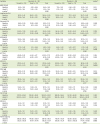2. Chalasani N, Younossi Z, Lavine JE, Diehl AM, Brunt EM, Cusi K, Charlton M, Sanyal AJ. The diagnosis and management of non-alcoholic fatty liver disease: practice guideline by the American Association for the Study of Liver Diseases, American College of Gastroenterology, and the American Gastroenterological Association. Hepatology. 2012; 55:2005–2023.


3. Buzzetti E, Pinzani M, Tsochatzis EA. The multiple-hit pathogenesis of non-alcoholic fatty liver disease (NAFLD). Metabolism. 2016; 65:1038–1048.


5. Moghaddasifar I, Lankarani KB, Moosazadeh M, Afshari M, Ghaemi A, Aliramezany M, Afsar Gharebagh R, Malary M. Prevalence of non-alcoholic fatty liver disease and its related factors in Iran. Int J Organ Transplant Med. 2016; 7:149–160.


6. Shrestha UK. Non-alcoholic fatty liver disease (NAFLD) is it an emerging risk factor for coronary artery disease? J Adv Intern Med. 2012; 1:1–2.

8. Terao J. Factors modulating bioavailability of quercetin-related flavonoids and the consequences of their vascular function. Biochem Pharmacol. 2017; 139:15–23.


9. Lesjak M, Beara I, Simin N, Pintać D, Majkić T, Bekvalac K, Orčić D, Mimica-Dukić N. Antioxidant and anti-inflammatory activities of quercetin and its derivatives. J Funct Foods. 2018; 40:68–75.

10. Petersen B, Egert S, Bosy-Westphal A, Müller MJ, Wolffram S, Hubbermann EM, Rimbach G, Schwarz K. Bioavailability of quercetin in humans and the influence of food matrix comparing quercetin capsules and different apple sources. Food Res Int. 2016; 88:159–165.

11. Sumida Y, Niki E, Naito Y, Yoshikawa T. Involvement of free radicals and oxidative stress in NAFLD/NASH. Free Radic Res. 2013; 47:869–880.


12. Arias CF, Arias CF. How do red blood cells know when to die? R Soc Open Sci. 2017; 4:160850.

13. Diederich L, Suvorava T, Sansone R, Keller TC 4th, Barbarino F, Sutton TR, Kramer CM, Lückstädt W, Isakson BE, Gohlke H, Feelisch M, Kelm M, Cortese-Krott MM. On the effects of reactive oxygen species and nitric oxide on red blood cell deformability. Front Physiol. 2018; 9:332.



15. Yang W, Huang H, Wang Y, Yu X, Yang Z. High red blood cell distribution width is closely associated with nonalcoholic fatty liver disease. Eur J Gastroenterol Hepatol. 2014; 26:174–178.


17. Kasmi S, Bkhairia I, Harrabi B, Mnif H, Marrakchi R, Ghozzi H, Kallel C, Nasri M, Zeghal K, Jamoussi K, Hakim A. Modulatory effects of quercetin on liver histopathological, biochemical, hematological, oxidative stress and DNA alterations in rats exposed to graded doses of score 250. Toxicol Mech Methods. 2018; 28:12–22.


18. Mikstacka R, Rimando AM, Ignatowicz E. Antioxidant effect of trans-resveratrol, pterostilbene, quercetin and their combinations in human erythrocytes in vitro. Plant Foods Hum Nutr. 2010; 65:57–63.


19. Al-Omair MA, Sedky A, Ali A, Elsawy H. Ameliorative potentials of quercetin against lead-induced hematological and testicular alterations in Albino rats. Chin J Physiol. 2017; 60:54–61.


20. Keskin E, Dönmez N, Kılıçarslan G, Kandır S. Beneficial effect of quercetin on some haematological parameters in streptozotocin-induced diabetic rats. Bull Environ Pharmacol Life Sci. 2016; 5:65–68.
21. Mahmoud AM. Hematological alterations in diabetic rats - Role of adipocytokines and effect of citrus flavonoids. EXCLI J. 2013; 12:647–657.


22. Koren E, Kohen R, Ginsburg I. Polyphenols enhance total oxidant-scavenging capacities of human blood by binding to red blood cells. Exp Biol Med (Maywood). 2010; 235:689–699.


23. Xiao L, Luo G, Tang Y, Yao P. Quercetin and iron metabolism: what we know and what we need to know. Food Chem Toxicol. 2018; 114:190–203.


24. Lesjak M, Balesaria S, Skinner V, Debnam ES, Srai SK. Quercetin inhibits intestinal non-haem iron absorption by regulating iron metabolism genes in the tissues. Eur J Nutr. 2019; 58:743–753.


25. Mazhar M, Faizi S, Gul A, Kabir N, Simjee SU. Effects of naturally occurring flavonoids on ferroportin expression in the spleen in iron deficiency anemia in vivo. RSC Adv. 2017; 7:23238–23245.

26. Lesjak M, Hoque R, Balesaria S, Skinner V, Debnam ES, Srai SK, Sharp PA. Quercetin inhibits intestinal iron absorption and ferroportin transporter expression in vivo and in vitro. PLoS One. 2014; 9:e102900.

27. Hoffman R, Benz EJ Jr, Silberstein LE, Heslop H, Anastasi J, Weitz J. Hematology: basic principles and practice. 6th ed. Philadelphia (PA): Elsevier Health Sciences;2013.
28. Petruška P, Kalafová A, Kolesárová A, Zbynovská K, Latacz A, Capcarová M. Effect of quercetin on haematological parameters of rabbits: agender comparison. J Microbiol Biotechnol Food Sci. 2013; 2:1540–1549.
29. Selvakumar K, Bavithra S, Suganya S, Ahmad Bhat F, Krishnamoorthy G, Arunakaran J. Effect of quercetin on haematobiochemical and histological changes in the liver of polychlorined biphenyls-induced adult male Wistar rats. J Biomark. 2013; 2013:960125.







 PDF
PDF ePub
ePub Citation
Citation Print
Print




 XML Download
XML Download